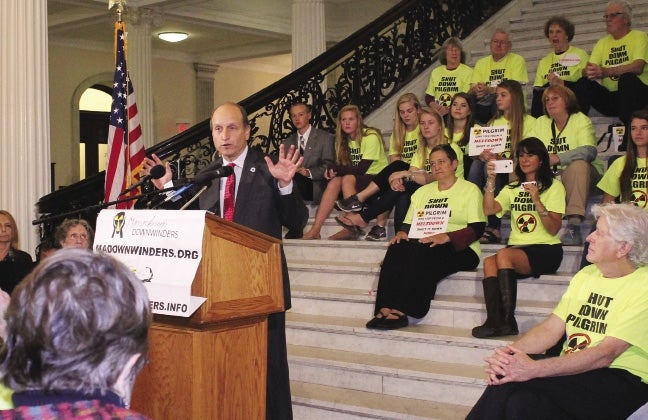As president and CEO of the North Central Chamber of Commerce, Roy M. Nascimento hears a lot from local businesses about the cost of electricity.
“We’re at a competitive disadvantage here in Massachusetts,” he said. “We have among the highest electric and energy rates in the country.”
For companies in the North Central area, particularly the manufacturers that help strengthen and stabilize the local economy, that’s a big deal.
“Many of them are being courted by states like North Carolina that have half the energy rates of Massachusetts,” Nascimento said.
Through August, ratepayers in Massachusetts were paying an average of 17.14 cents per kilowatt hour of electricity, the second highest in New England and the fourth highest in the country after Hawaii, Alaska and Connecticut, according to the U.S. Energy Information Administration.
When Entergy Corp., the owner of Pilgrim Nuclear Power Station, announced it would close the 680-megawatt Plymouth plant in 2019, it raised questions about how the state will ensure a reasonably affordable, consistent supply of power. Because nuclear power doesn’t produce greenhouse gas emissions, it also raised the question of how Massachusetts can meet its goals for fighting climate change.
In 2014, nuclear power generated 34 percent of New England’s energy, according to ISO New England, the regional agency responsible for the power grid. Another Entergy nuclear plant, the 620-megawatt Vermont Yankee Nuclear plant, shut down at the end of that year. Once both plants are offline, the region will be down to three plants supplying a total of 3,406 megawatts.
To the power generation industry, though, the path forward seems clear.
“Anytime you take away a facility of that size, there’s obviously going to be an impact,” said Dan Dolan, president of the New England Power Generators Association, which represents power plants. “This is actually how the market has been designed, is to be able to withstand this kind of retirements from the system and incentivize new plants to replace them.”
The three-year notice Entergy gave offers the time for other industry players to plan and build new plants, Dolan said.
Right now, there’s 11,000 megawatts of proposed new generation in the region’s pipeline, according to ISO New England. Two-thirds of that potential capacity would come from burning natural gas, while most of the rest would come from wind.
One concern about natural gas is that, while it creates less pollution than coal or oil, it’s still a source of greenhouse gasses and other emissions.
Matthew A. Beaton, the Massachusetts secretary of energy and environmental affairs, said the state’s mission is to ensure that electricity is affordability and reliable while also limiting its environmental impact.
The state has promised to reduce carbon emissions 25 percent from 1990 levels by 2020, but as of 2012 it had pushed them down only 15 percent. To achieve significant further reductions, Gov. Charlie Baker has proposed encouraging utilities to make long-term deals to import electricity from hydropower facilities in Canada.
“The original estimate for how we would get to that 2020 goal had one fifth of carbon reductions [coming] from developing one line of hydropower,” Beaton said. “Without it, we fall short of our environmental goals, and that’s only made worse by the retirement of Pilgrim.”
Beaton said the governor’s plan would support proposals involving a mix of wind and hydropower resources. Because wind is an intermittent power source, he said, it’s important to back it up with a more consistent kind of generation.
In any case, Beaton said, any renewable energy proposals under the plan would have to show they can compete on cost with other energy sources.
Aside from greenhouse gas concerns, another sore point for some in the state’s growing reliance on natural gas is the construction of new pipelines to bring more of the fuel into the region.
Existing pipelines provide plenty of natural gas during the summer, but in the winter, when gas is also in demand for heating, they just don’t have enough capacity. Instead, generators are forced to buy liquefied natural gas (LNG), which is brought into the region on tankers and can be expensive.
In early October, the state gave a green light to utilities to make deals for the construction of new pipelines, passing some costs on to ratepayers.
The North Central Chamber recently endorsed one of the proposed pipelines, Kinder Morgan’s Northeast Expansion Project, which would bring gas from the huge Marcellus Shale formation in Pennsylvania through Western Massachusetts and New Hampshire to the Boston area.
Nascimento said the chamber supports the development of alternative energy, but it also sees affordable natural gas as a key to the region’s economic competitiveness.
“We think it needs to be an all-of-the-above policy,” he said.
The construction of the pipelines is a classic case of overbuild, creating an expensive, permanent infrastructure to solve a problem that only exists for a small part of the year, said Kathryn R. Eiseman, president of the Pipe Line Awareness Network for the Northeast Inc., The pipelines would hurt landowners and create environmental problems.
“The energy cost crunch in New England is concentrated in the winter, so solutions should be focused on aligning winter supply with winter demand,” she said in an email message. “In the short-term, this can include bringing in more LNG, as well as continuing the trend of reducing demand through energy efficiency, demand response, and similar measures.”
Beaton said his office will work to curb the pipeline’s potential negative effects. It’s also working to develop long-term advances in renewable energy, including continuing to support solar development and seeking storage solutions that would make intermittent energy sources more valuable.
In the meantime, it’s crucial to develop reliable, affordable sources of electricity for the short term as well, Beaton said.
“We need this natural gas,” he said. “When our businesses are looking to expand—or even maintain businesses in Massachusetts, the cost of electricity is one of the main things we hear.”

